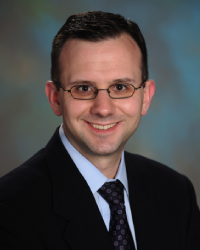Surgical Treatment for Hearing Loss
Some types of hearing loss hearing loss can be treated with special types of surgery. TriHealth audiologists work together with trained ear, nose and throat physicians to treat patients who would benefit from advanced technologies, such as surgical implants, to treat hearing loss. Below we have provided some information to help you better understand some of these surgical options.To be evaluated for your individualized plan of care for hearing loss, please schedule an appointment with a TriHealth ENT at 513 246 7010.
Surgical Options for Sensorineural Hearing Loss
Cochlear Implants
A cochlear implant is a small electronic device that can restore hearing and speech understanding to someone who is profoundly deaf or severely hard-of-hearing. The implant consists of an external portion that sits behind the ear and a second portion that is surgically placed under the skin.
A collaborative team of TriHealth board-certified ENT physicians and audiologists coordinate surgical care and therapy to help these patient relearn the sense of hearing.
Baha® Bone Conduction Implants—This is for single sided deafness, conductive hearing loss, and mixed conductive and sensorineural hearing loss.
For people with single sided deafness or chronic conductive hearing loss, a Baha® bone conduction implant may be the answer. The Baha system uses a titanium implant that is surgically placed in the skull bone behind the non-functioning ear. A small sound processor then connects to the implant, either with a magnet or small stem protruding from the skull.
The surgery is conducted by a TriHealth board-certified ENT physician. Your audiologist then works with you to fit and adjust the sound processor.
Download an informational brochure about Baha® Bone Conduction Implants
Conductive Hearing Loss
PE Tubes
This surgical treatment involves placing a small tube through the eardrum to allow air into the middle ear. This surgery is commonly performed in children or adults due to chronic middle ear fluid and infections. This fluid frequently clears without surgery, but can sometimes linger and cause hearing loss and other serious damage to the middle ear. These tubes can help restore hearing by draining the fluid and healing the inflammation in the middle ear.
Stapedectomy
This is a surgery is a treatment for a disease called otosclerosis. In otosclerosis, the smallest bone in the ear, the stapes, becomes fixed to surrounding bone resulting in conductive hearing loss. The surgery will replace this bone with a prosthesis, significantly improving sound conduction and hearing.
Middle Ear Surgeries
Some diseases of the middle ear can also cause conductive hearing loss. The two most common causes of this loss are a hole in the ear drum or an erosion of one or more of the hearing bones. When there is a hole in the eardrum, sound is not transmitted appropriately to the hearing bones and into the inner ear. Similarly, when the hearing bones are not joined together, sound is not effectively conducted from the ear drum to the inner ear. Surgical interventions can fix holes in the eardrum and/or replace missing hearing bones with prosthetic bones.
BAHA
This procedure described above can be used to treat some patients with conductive hearing loss.
Our Team of Experts
Many of our otolaryngologists here at TriHealth treat patients with hearing loss medically and also perform some of the surgical procedures to treat these patients. We have several with interest and expertise in surgical treatments that include advanced technology and are highlighted below.
| The Team |
|---|

Brian Goico, MDBrian Goico, MD, is a board-certified ENT with multiple clinical interests including ear diseases and treatments, pediatric ear, nose, and throat disorders, sinonasal disease, and thyroid/parathyroid surgery. Dr. Goico has a particular interest in hearing preservation and restoration, with a focus on cochlear implantation, bone anchored hearing aid implantation, and middle ear and mastoid surgery. He graduated from the Northwestern University Feinberg School of Medicine and completed residency at The University of Cincinnati Medical Center/Cincinnati Children’s Hospital. |

Jamie Welshhans MDDr. Jamie Welshhans is a board certified otolaryngologist who provides a broad range of ear, nose and throat care and operative procedures, including advanced middle ear and hearing surgeries. She completed medical school at the University of Cincinnati in 2012, followed by a prestigious residency in otolaryngology at the University of Cincinnati, graduating in 2017. She is not only experienced, training at a high volume center and currently running a busy practice, but is also up to date on the most recent advances in otologic surgery. Dr. Welshhans stresses the importance of hearing rehabilitation as a way to improve her patients’ interpersonal connections. In her spare time, she loves attending performances of the Cincinnati Ballet, spending time outdoors with her husband and dogs, and trying all the newest Cincinnati restaurants. |